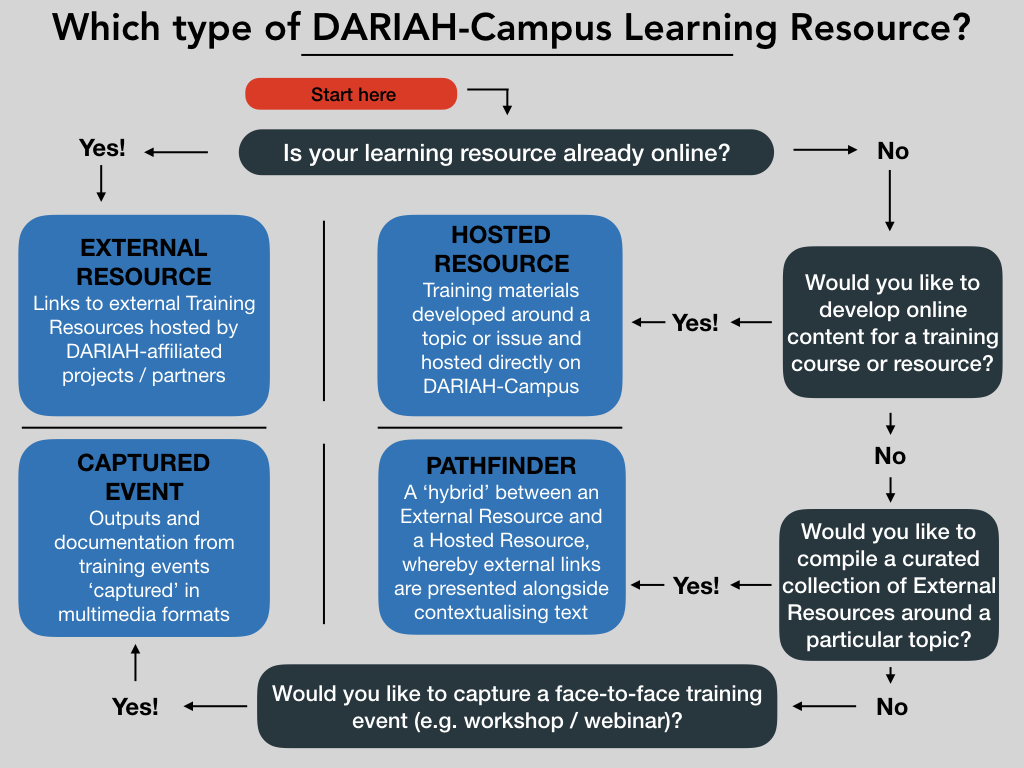Proposing a contribution
Picking the appropriate Resource type
So you want to make a contribution to DARIAH-Campus?
That’s great!
Here are the steps you need to go through in order to get your contribution published. If you have training materials, or events that you would like to contribute to DARIAH-Campus, you can do so in a number of ways.
View the flowchart below to see what kind of resource you want to contribute.

Once you know what kind of contribution you’d like to make, you can submit your proposal.
Submitting your proposal
If you have a resource in mind, you first need to send us some information so that we can set things up for you to get started.
-
If you don’t already have a GitHub account, you should register for one, as you will need this to complete the entire contribution process.
-
You will need to fill in the form found here: Propose a Resource form
This will ask you for the following information:
- Title of resource
- All people to be listed as authors, contributors or editors (no need to distinguish which at this stage, we just want the names!)
- If you need to add a new Organisation to DARIAH-Campus, please give us the name, a logo and a URL for the Organisation website.
- Type of resource (External Resource / Hosted Resource / Pathfinder / Captured Event)
- Any new tags you want to add to the list (please ensure that your tag isn’t already listed on DARIAH-Campus - the full list is here)
- The Learning Outcomes that users will experience by engaging with your resource (typically 2-4 different outcomes)
- Brief Abstract for the resource (approx 50 words max)
- The names of any organisations (e.g. research institutes, research infrastructures, projects) that will be named in your resource (this is particularly pertinent to Captured Events)
- Submit your form on GitHub and we will get back to you within a week to let you know when you can start the next step.
Writing Learning outcomes
We require learning outcomes to be included in all hosted resources (those that are hosted directly on DARIAH-Campus), and we strongly encourage them to be included on external resources (those that link to the resource on another site). To help you write learning outcomes for your resource, we have compiled the following guide.
Learning outcomes should be clear and concise, and always begin with a verb that demonstrates what a learner will be able to do after they have completed your resource. Learning Outcomes are different from Learning Objectives that one might write for a course or module as they convey the achievements rather than the proposed goals.
The following table provides examples that should help you distinguish between objectives and outcomes:
| Objectives | Outcomes | |
|---|---|---|
| Purpose | statements that define the expected goal overall | statements that reflect what the learner will be able to do as a result of completing the course |
| What do they define? | what the instructor wants (to cover) | what the student gets (to be able to do) |
| Structure | may include verbs such as introduce, cover, discuss, explore, study, present, etc. | may include verbs such as: identify, distinguish, understand, recognise, use (a tool or a method), implement, demonstrate, categorise, compare, differentiate, apply, evaluate, create etc. |
| Example | The goal of this course is to provide a basic introduction to e.g. dictionaries, their structure, and ways in which dictionaries evolved over time. | Upon completion of this course, students will be able to: - appreciate the complexity of the dictionary genre and its history; - analyse the structure of a dictionary entry; - categorise dictionaries based on their content and/or target audience; - understand the role played by the medium in which the dictionary is compiled and consumed |
Next steps
Once your information is set up ready, we will send you a notice via GitHub. You can then start adding your resources to DARIAH-Campus. There are two ways you can do this. We strongly recommend using the Content Management System, especially if you are not familiar or confident using GitHub. If you do want to use GitHub and need guidance, we have some instructions for use here.